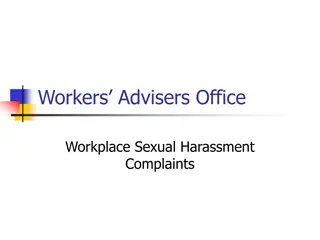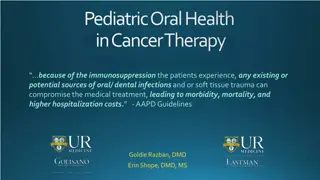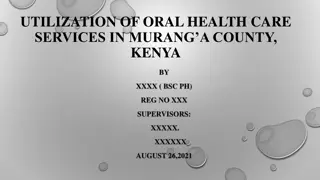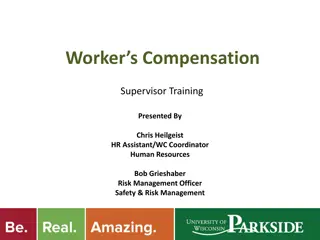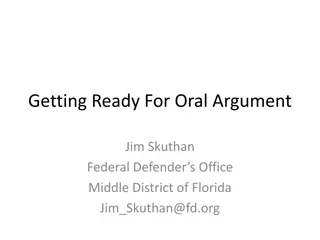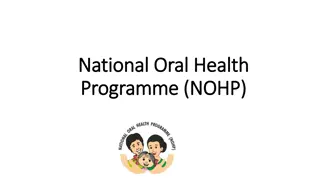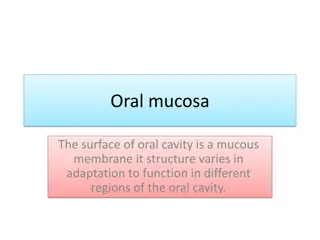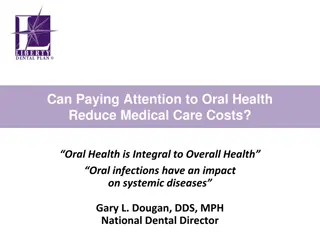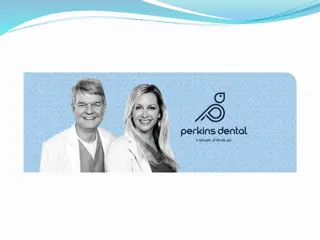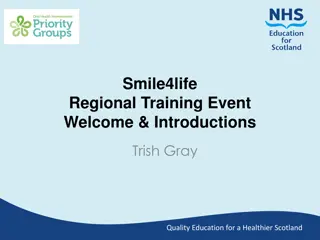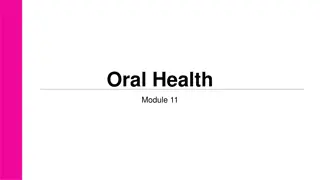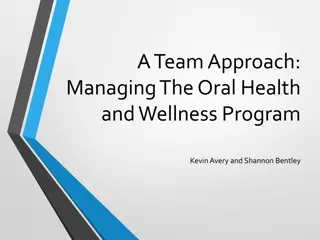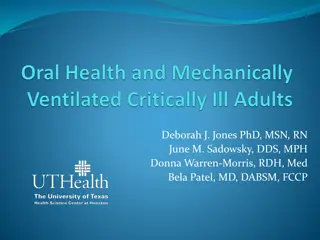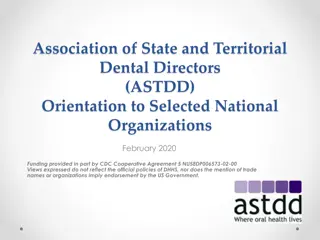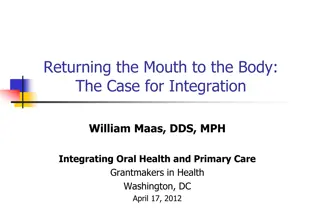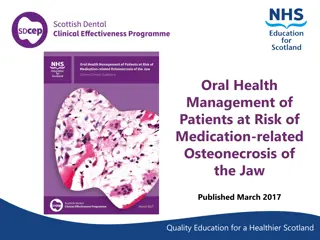Importance of Oral Health for Community Health Workers
Oral health is crucial for overall well-being, impacting aspects from chewing to psychosocial health. Untreated oral diseases like dental caries and gum disease are prevalent, underscoring the significance of early detection and prevention. Community Health Workers play a vital role in raising awareness and promoting oral health to ensure better quality of life for individuals.
Download Presentation

Please find below an Image/Link to download the presentation.
The content on the website is provided AS IS for your information and personal use only. It may not be sold, licensed, or shared on other websites without obtaining consent from the author.If you encounter any issues during the download, it is possible that the publisher has removed the file from their server.
You are allowed to download the files provided on this website for personal or commercial use, subject to the condition that they are used lawfully. All files are the property of their respective owners.
The content on the website is provided AS IS for your information and personal use only. It may not be sold, licensed, or shared on other websites without obtaining consent from the author.
E N D
Presentation Transcript
Overview of Oral Health Topics for the Community Health Worker November 17, , 2016 Catherine A. Demko, PhD Case Western Reserve University School of Dental Medicine Created with support from the Ohio MedTAPP HCA
As a Community Health Worker, how does oral health fit it? You are not healthy without good oral health. David Satcher, Surgeon General s Report, 2000
Purpose of the module Brief overview of oral health issues Raise awareness of oral health in the context of general health Introduce oral health in the context of CHW scope of practice Provide resources for oral health promotion
What do we mean by oral health? Dental health refers to teeth and gums. Oral health includes everything related to your mouth: Jaws Chewing muscles Roof of your mouth Linings of the mouth and throat Tongue Lips Salivary glands Mouth and face pain Oral or throat cancer
Oral health is essential to quality of life Oral health affects biting, chewing, smiling, speaking, and psychosocial wellbeing Oral pain can cause: Poor school performance in children Work loss in adults Difficulty chewing and poor nutrition Costly emergency department visits Dental decay and tooth loss can lead to: Aesthetics and self-image issues Speech and language development problems Costly restoration
How common are oral diseases? Dental caries is the most common chronic disease of childhood. It is 4-5 times more common than asthma. In Cleveland schools, 25-30% have untreated decay; Gum disease affects 47% of U.S. Adults. 50,000 oral cancers are diagnosed annually. Oral cancer causes 10,000 deaths a year. Diagnosis is often late; early detection is key
The mouth is a gateway. Taking care of the mouth helps keep the rest of the body healthy.
Oral health General health Scientific research has established a link between mouth infections and serious medical problems, such as: Diabetes* Heart disease Lupus Oral cancer Rheumatoid arthritis Stroke These are links, but we don t know for sure if the relationships are Causal; mostly associations related to inflammation
Part 2: Basic Issues in Oral Diseases Describe each of 3 diseases What are the causes of each disease What are risk factors How can we prevent these oral diseases?
Overview 3 most common dental diseases are caries, periodontal disease and oral cancer. Dental caries is the most common chronic disease of childhood. Dental is the most unmet health need
Basic tooth structure & gums Enamel Dentin Pulp Root Surrounded by Gum Tissue and Bone
Caries: How do teeth develop decay? Bacteria break down food into acids that eat away at the tooth. Bacteria DECAY Teeth Food
What increases the likelihood of tooth decay? Risk factors shared by adults and children include: Bacteria: High bacterial counts Family history of (cavities) Diet: Frequently consuming sugary foods & drinks Inadequate fluoride Low Saliva or Dry Mouth from many prescription drugs Low socio-economic status may indicate poor diet, lack of access to care Aging, disease, and disease treatment can contribute to risk for tooth decay in adults
2. Periodontal (Gum) Disease Infection of the tissues that hold teeth in place Healthy Bacteria and inflammation break down bone & gum tissue Periodontal disease
What increases risk of gum disease? Smoking: significant risk factors. Hormonal changes in girls/women. Diabetes: Increases risk for many infections, including gum disease. Other illnesses: can negatively affect gums; diseases such asAIDS and its treatments; cancer treatments
3. Mouth and Throat Cancer Cancer of the mouth, tongue, throat, tonsils, lymph nodes Risk of oral cancer increases with age. Most oral cancers occur after age 40. Survival in AA males is the poorest of any group
Risk factors that increase the likelihood of oral cancer & other diseases Oral cancer Gum disease Lung Cancer Liver disease Oral cancer Highest risk for Oral Cancer
Steps to Reduce Risk for Oral Disease Oral Cancer Periodontal Disease Caries Strong health promotion messages for these 3 oral diseases
Part 3: Prevention and Oral Health Promotion Preventive behaviors for oral health Routine self-care, brushing & flossing Fluoride toothpaste Dietary choices; limit sugar intake Stop tobacco use; limit alcohol Alleviate dry mouth symptoms Routine preventive visits; catch problems early
CHW and Oral Health CANNOT diagnose oral health problems CANNOT offer advice about treatment Follow one of the models in your book to understand your client s belief about oral health CAN offer reliable information CAN offer resources for additional information CAN offer resources for access to care CAN provide brief health promotion messages
Oral Health Promotion Messages Professional Care Establish a dental home; a routine source of care. Visit your dentist regularly for professional cleanings and exams.
Messages: Brushing Regular brushing and flossing are the foundation of good oral health. 2 3 minutes, twice a day, and floss to get rid of food debris and plaque. Use a soft toothbrush and focus on the area where the tooth meets the gum. Use fluoride toothpaste Supervise children until about 8yrs old.
Messages: Dietary Habits Avoid frequent snacking on sugary foods Avoid sipping sugary beverages all day Drinking water throughout the day helps rinse the mouth and neutralize the acids that cause decay. Choose healthy snacks for self and children
Messages: Other Behaviors Avoid tobacco (all forms); refer to QuitLine Limit alcohol Sugar-free chewing gum with Xylitol
Summary for CHW Role in Oral Health Ask Questions Do you have any problems or concern with your teeth? Does anything in your mouth hurt? Do you have a regular dentist? When was the last time you visited a dentist? How often do you brush/floss your teeth? Provide health education/promotion messages Provide resources and/or referrals for dental services
CHW and Community Oral Health What characterizes oral health in a community? What resources and strengths exist for oral health? What resources would enhance oral health for community members? What are existing or possible barriers? Who would have information about oral health in children, adults, elderly, special needs? Is oral health a good topic for community-level health promotion?
Questions? Website Resources https://oralhealthamerica.org/resources/ http://www.mouthhealthy.org/en http://www.odh.ohio.gov/odhprograms/ohs/oral/oraledumat/pteduc.aspx


